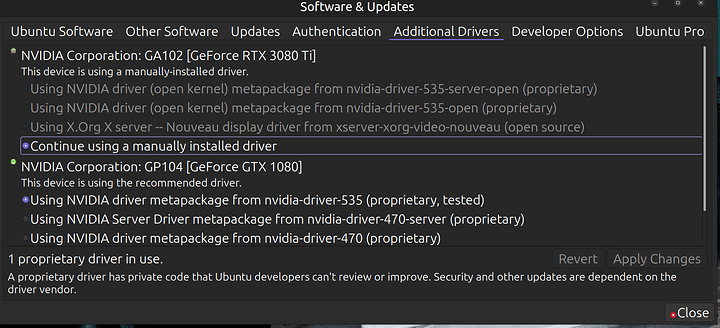HI All,
I’ve been using QEMU/KVM successfully for months, without issue. Zero, none.
Successfully pass-through of an NVME during this time, without issue. Zero, none.
Implying here that the usual prerequisites for virtualization have been met.
I’ve recently added a W10 VM (pass-through NVME) successful boot, no problems. Once I was able to determine it was functional I attempted to add my GTX 1080. This is when the problems began.
Virt-manager freezes and have 2-3mins spits out this error. None of my VMs are able to function. .
Error starting domain: Cannot recv data: Connection reset by peer
Traceback (most recent call last):
File "/usr/share/virt-manager/virtManager/asyncjob.py", line 72, in cb_wrapper
callback(asyncjob, *args, **kwargs)
File "/usr/share/virt-manager/virtManager/asyncjob.py", line 108, in tmpcb
callback(*args, **kwargs)
File "/usr/share/virt-manager/virtManager/object/libvirtobject.py", line 57, in newfn
ret = fn(self, *args, **kwargs)
^^^^^^^^^^^^^^^^^^^^^^^^^
File "/usr/share/virt-manager/virtManager/object/domain.py", line 1402, in startup
self._backend.create()
File "/usr/lib/python3/dist-packages/libvirt.py", line 1379, in create
raise libvirtError('virDomainCreate() failed')
libvirt.libvirtError: Cannot recv data: Connection reset by peer
After this occurs, I can no longer connect to QEMU/KVM, even after restarting services. I need to perform a full reboot in order to review what could be going wrong.
Each has their own IOMMU grouping so I think that is free and clear.
00:00.0 Host bridge: Intel Corporation Device 4c53 (rev 01)
00:01.0 PCI bridge: Intel Corporation Device 4c01 (rev 01)
00:01.1 PCI bridge: Intel Corporation Device 4c05 (rev 01)
00:06.0 PCI bridge: Intel Corporation Device 4c09 (rev 01)
00:14.0 USB controller: Intel Corporation Tiger Lake-H USB 3.2 Gen 2x1 xHCI Host Controller (rev 11)
00:14.2 RAM memory: Intel Corporation Tiger Lake-H Shared SRAM (rev 11)
00:16.0 Communication controller: Intel Corporation Tiger Lake-H Management Engine Interface (rev 11)
00:17.0 RAID bus controller: Intel Corporation Device 43d6 (rev 11)
00:1b.0 PCI bridge: Intel Corporation Tiger Lake-H PCIe Root Port #17 (rev 11)
00:1b.4 PCI bridge: Intel Corporation Device 43c4 (rev 11)
00:1c.0 PCI bridge: Intel Corporation Tiger Lake-H PCIe Root Port #1 (rev 11)
00:1c.4 PCI bridge: Intel Corporation Tiger Lake-H PCI Express Root Port #5 (rev 11)
00:1c.6 PCI bridge: Intel Corporation Device 43be (rev 11)
00:1d.0 PCI bridge: Intel Corporation Tiger Lake-H PCI Express Root Port #9 (rev 11)
00:1d.4 PCI bridge: Intel Corporation Device 43b4 (rev 11)
00:1f.0 ISA bridge: Intel Corporation Z590 LPC/eSPI Controller (rev 11)
00:1f.3 Audio device: Intel Corporation Tiger Lake-H HD Audio Controller (rev 11)
00:1f.4 SMBus: Intel Corporation Tiger Lake-H SMBus Controller (rev 11)
00:1f.5 Serial bus controller: Intel Corporation Tiger Lake-H SPI Controller (rev 11)
01:00.0 VGA compatible controller: NVIDIA Corporation GA102 [GeForce RTX 3080 Ti] (rev a1)
01:00.1 Audio device: NVIDIA Corporation GA102 High Definition Audio Controller (rev a1)
02:00.0 VGA compatible controller: NVIDIA Corporation GP104 [GeForce GTX 1080] (rev a1)
02:00.1 Audio device: NVIDIA Corporation GP104 High Definition Audio Controller (rev a1)
03:00.0 Non-Volatile memory controller: Solidigm P41 Plus NVMe SSD (DRAM-less) [Echo Harbor] (rev 03)
04:00.0 Non-Volatile memory controller: Intel Corporation SSD 665p Series [Neptune Harbor Refresh] (rev 03)
05:00.0 Non-Volatile memory controller: Solidigm P41 Plus NVMe SSD (DRAM-less) [Echo Harbor] (rev 03)
07:00.0 Ethernet controller: Aquantia Corp. AQtion AQC107 NBase-T/IEEE 802.3an Ethernet Controller [Atlantic 10G] (rev 02)
08:00.0 Network controller: Intel Corporation Wi-Fi 6E(802.11ax) AX210/AX1675* 2x2 [Typhoon Peak] (rev 1a)
09:00.0 Non-Volatile memory controller: Solidigm P41 Plus NVMe SSD (DRAM-less) [Echo Harbor] (rev 03)
Can someone please offer their advice? Appreciate it in advance.
WWED
